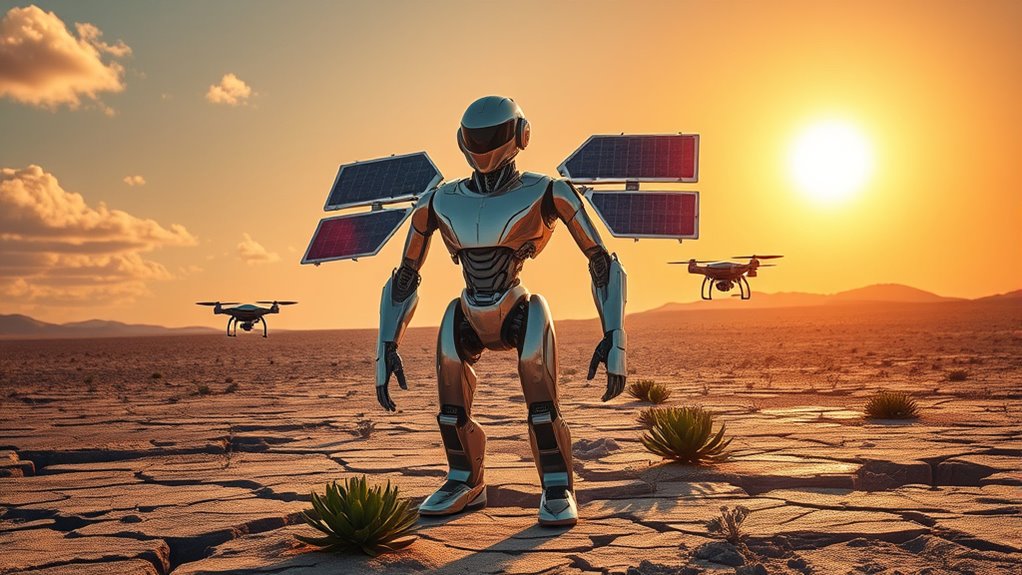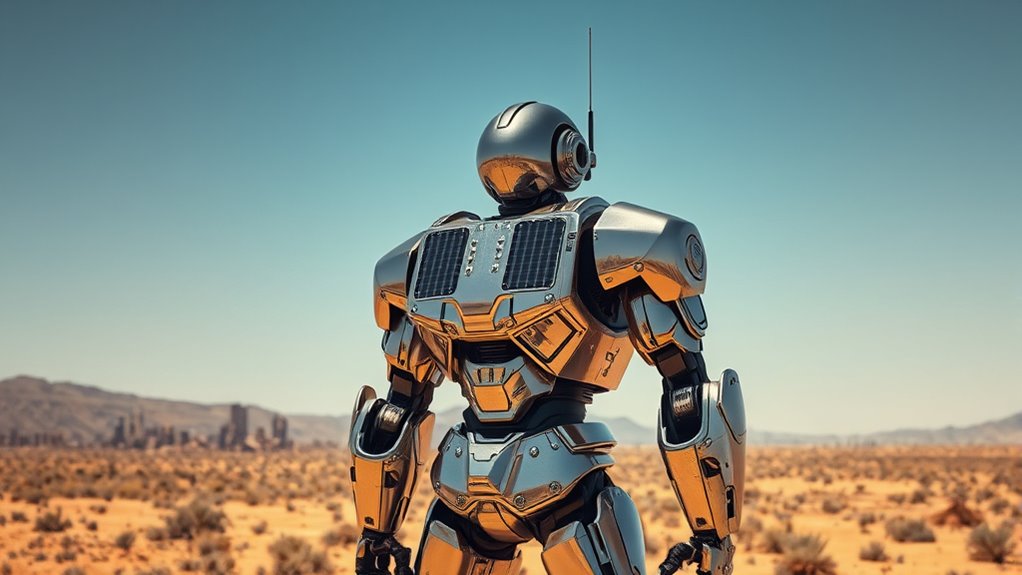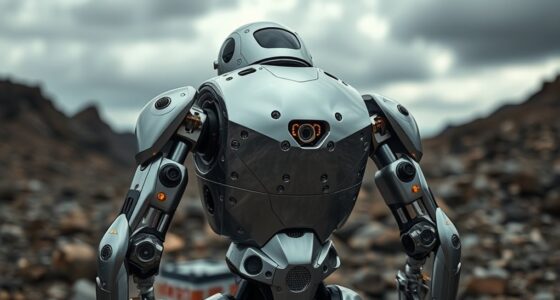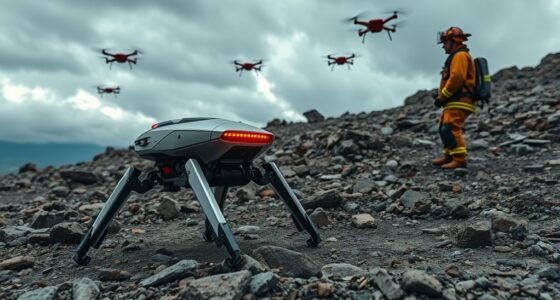Solar-powered robots are revolutionizing sustainable tech by enabling off-grid farming, environmental monitoring, and space exploration with minimal environmental impact. They operate on renewable energy, reducing reliance on fossil fuels, and can be equipped with AI and IoT for smarter performance. These innovations not only support eco-friendly development but also pave the way for future applications like space missions. Curious about how these systems could shape a resilient, green future? There’s much more to uncover.
Key Takeaways
- Solar-powered robots enable sustainable survival solutions by providing autonomous energy for off-grid and extreme environment operations.
- They support agricultural resilience, food production, and environmental monitoring during catastrophic or resource-scarce scenarios.
- Advanced solar tech enhances robot durability and efficiency, ensuring reliable performance in challenging conditions.
- AI and IoT integration optimize energy use and operational adaptability in unpredictable or apocalyptic environments.
- These technologies offer eco-friendly, cost-effective alternatives to fossil fuels, facilitating long-term sustainability.
The Rise of Solar-Powered Robotics in Sustainable Development

The rise of solar-powered robotics marks a significant advancement in sustainable development, as these technologies directly address environmental challenges while enhancing efficiency across various sectors. You’ll see them in agriculture, where robots like Ladybird map farms with lasers and cameras, boosting crop yields while minimizing environmental impact. These robots operate on solar energy during the day and batteries at night, making farming more autonomous and sustainable. They also help conserve soil by steering precisely and reducing disruption. In clean energy, autonomous robots clean solar panels without water, maintaining maximum efficiency. Additionally, their ability to perform tasks using solar energy reduces reliance on fossil fuels and decreases carbon emissions. This innovation is further supported by advancements in energy storage technologies, which enable continuous operation even when sunlight is unavailable. Moreover, ongoing research into low-impact manufacturing techniques ensures that the production of solar-powered robots remains environmentally friendly. Developing eco-friendly materials for robot components further minimizes their environmental footprint. Overall, solar-powered robots support eco-friendly farming, renewable energy infrastructure, and environmental conservation, playing a vital role in advancing sustainable practices worldwide. Their integration of sound design techniques enhances operational awareness and safety through real-time audio cues, further improving their effectiveness. Their versatility makes them key players in shaping a greener future.
How Solar Technology Enhances Remote and Off-Grid Operations

Solar technology substantially boosts the reliability of power supply in remote and off-grid locations by providing a consistent energy source where traditional grids are unavailable. Off-grid solar systems, combined with Battery Energy Storage Systems (BESS), ensure stable power by managing energy supply and demand, even in harsh conditions. High-efficiency solar panels and advanced charge controllers optimize energy absorption and extend battery life. Rugged solar components withstand extreme weather, like high winds and intense heat, maintaining continuous operation. Solar power reduces reliance on fuel generators, cutting operational costs and environmental impact. The high fiber content of chia seeds enhances their ability to stabilize blood sugar levels, further supporting energy regulation in off-grid systems. Scalable systems can be tailored to meet specific needs, offering flexibility. These advancements make solar-powered solutions ideal for supporting remote operations such as telecommunications, security, and data collection, ensuring consistent power in isolated areas.
Agricultural Innovations Driven by Solar-Enabled Robots

As advancements in robotics and renewable energy converge, agricultural practices are experiencing a transformative shift. Solar-enabled robots like FarmDroid FD20 now handle fully autonomous seeding, optimizing planting schedules while reducing manual effort. They also protect crops from pests and diseases, perform tasks like tilling, sowing, and spraying fertilizers without human intervention.
Equipped with navigation systems, these robots detect obstacles and plan efficient routes, enhancing productivity in diverse environments. They substantially cut reliance on fossil fuels, making farming more sustainable. Furthermore, they reduce chemical use, conserve water and fertilizers, and monitor soil conditions to boost yields. Renewable energy is a key driver in making these innovations feasible and environmentally friendly. Incorporating energy-efficient technology can further enhance the sustainability of these agricultural systems.
This integration of solar power and robotics not only improves farm efficiency but also promotes environmentally friendly practices, paving the way for scalable, sustainable agriculture. Regular maintenance and proper cleaning of the robots’ components can extend their lifespan and ensure consistent performance, similar to paint sprayer maintenance, which is crucial for optimal operation and durability. Implementing cybersecurity measures is essential to protect these automated systems from potential cyber threats, ensuring safe and reliable operation. Additionally, utilizing versatile equipment allows these robots to adapt to various tasks and terrains, maximizing their utility on the farm.
Advancements in Solar Cell Efficiency for Larger Robotic Systems

Recent advances in solar cell technology are transforming how larger robotic systems harness renewable energy. High-efficiency panels now generate more power from less surface area, making them ideal for bigger robots. Researchers are developing lightweight, affordable materials to improve portability and reduce weight.
Advances in solar cell tech enable larger robots to harness renewable energy efficiently and sustainably.
Automated robotic platforms accelerate manufacturing and testing, ensuring quicker development of better solar cells. These systems improve material stability, helping panels withstand environmental stresses and last longer. Additionally, AI-driven optimization and predictive analytics analyze data from experiments, fine-tuning performance and durability. Robotic assembly lines, like NASA’s PAPA technology, streamline production and lower costs.
Furthermore, advances in scalable manufacturing are crucial for ensuring solar panels maintain performance under diverse environmental conditions. Incorporating robustness testing protocols ensures consistent operation across varying climates and stresses. The combination of efficiency improvements, scalable manufacturing, and enhanced durability enables larger robots to operate more autonomously, sustainably, and cost-effectively. This progress is supported by ongoing research into renewable energy integration, which aims to maximize energy efficiency and resilience in robotic systems. Ultimately, these developments pave the way for a future where solar-powered robots can tackle bigger, more complex tasks.
Solar Robots in Space: Expanding the Frontiers of Exploration

Have you ever wondered how robots powered by solar energy are pushing the boundaries of space exploration? These solar-powered robots have been essential in exploring planets and moons, collecting data, and performing experiments in extreme environments. Their durability allows them to withstand harsh space conditions and cover extensive areas both on planets and in orbit. Thanks to technological advances, they now operate longer and more efficiently. Solar energy provides a reliable power source that enables sustained operations even in remote locations. These advancements also include cost-effective and environmentally friendly solutions that make solar robots a sustainable choice for long-term missions. Additionally, innovations in filtration systems help protect sensitive instruments from dust and debris, increasing mission longevity. Improved power storage techniques ensure continuous operation during periods of low sunlight, further enhancing mission success. Their autonomous functions reduce reliance on ground control, enabling extended missions that last months or years. The integration of energy management systems optimizes power usage and prolongs operational life. Equipped with advanced sensors, they monitor environments and gather critical information. Solar power’s renewable nature makes these robots cost-effective and environmentally friendly, while their lightweight design enhances mobility. Overall, solar robots are transforming how we explore space, opening new frontiers with reliable, sustainable technology.
Economic Impacts of Solar-Powered Robot Deployment

Solar-powered robots are revolutionizing the economic landscape of energy and technology sectors by offering cost-effective and sustainable solutions. They reduce operational costs by relying on renewable energy, cutting expenses linked to fossil fuels. Their increased efficiency allows tasks to be performed quickly and precisely, boosting productivity. Incorporating renewable energy sources into robotic systems further enhances their sustainability and reduces environmental impact. This shift also encourages innovation in robotic design and drives investments in green technology. Furthermore, the use of sustainable energy in robotics promotes long-term environmental benefits and aligns with global efforts to combat climate change.
This shift creates new job opportunities in designing, installing, and maintaining these robots, stimulating local economies. Lower energy costs for infrastructure are another benefit, as solar-powered robots help reduce ongoing expenses. Additionally, large-scale solar projects benefit from economies of scale, making deployment more affordable. Governments often provide incentives, further lowering costs and encouraging adoption. Moreover, the integration of Vetted solar technology ensures reliability and optimal performance of these robotic systems. Implementing trustworthy brands and products can help maximize the benefits and ensure long-term success.
Future Possibilities: Humanoid and Complex Robots Powered by Solar Energy

As photovoltaic technology continues to advance, the potential for powering humanoid and complex robots with solar energy becomes increasingly promising. Improvements in efficiency, durability, and cost will make solar-powered robots more practical and sustainable.
Currently, no humanoid robots are fully solar-powered, but models like Atlas Unplugged use rechargeable batteries charged by solar energy. Future designs will focus on optimizing energy management systems to maximize solar intake, predict weather, and extend operational time.
As robots evolve to carry their own batteries and improve power efficiency, they’ll be capable of performing complex tasks such as environmental monitoring, disaster response, and space exploration. Advances in materials and integration will enable these robots to operate longer in remote or challenging environments, reducing reliance on traditional power sources.
Integrating Solar Robots With AI and Iot for Enhanced Performance

Integrating AI and IoT with solar robots substantially enhances their performance by enabling real-time data analysis and adaptive responses. You can optimize energy production by adjusting panel angles and energy distribution based on environmental changes captured by IoT sensors.
AI predicts equipment failures, reducing downtime and increasing reliability, while IoT continuously monitors parameters like temperature and current output. This seamless data flow allows for automated adjustments, ensuring maximum efficiency.
AI also helps integrate solar energy smoothly into the grid and manages large-scale solar farms, lowering operational costs. By analyzing weather forecasts and energy demand, AI optimizes storage and distribution.
Together, AI and IoT create dynamic control systems that adapt to environmental shifts, boosting performance and making solar-powered robots more effective and reliable for sustainability efforts.
Challenges and Opportunities in the Transition to Solar-Powered Robotics

Shifting to solar-powered robotics presents several significant challenges that can hinder widespread adoption. Environmental limitations mean your robots depend on sunlight, which can be unpredictable and varies by location and time.
You’ll also face battery and storage issues; large batteries needed for nighttime or cloudy conditions add weight and size, reducing practicality. Material and technological constraints, like silicon photovoltaics, limit miniaturization and efficiency.
Economically, high costs for advanced solar panels and storage solutions slow down implementation, especially in commercial sectors. Innovation barriers arise from limited market demand for new photovoltaic technologies, making development less attractive.
Despite these hurdles, opportunities exist in sustainability, extended autonomy, diverse applications, and technological advances, which can ultimately drive the transition forward.
Frequently Asked Questions
How Long Can Solar-Powered Robots Operate Without Sunlight?
You want to know how long solar-powered robots can run without sunlight. It depends on their battery capacity and technology.
Some, like solar drones, can stay airborne for months with battery help. Others, like the Ladybird robot, operate for about three days on a single charge.
Typically, their operation time ranges from a few hours to several days, depending on energy storage and usage needs.
Advances in batteries are key to longer autonomous periods.
What Are the Limitations of Current Solar Cell Technology for Robotics?
You find that current solar cell technology faces limitations like high costs and limited efficiency, especially on small scales. Silicon cells are rigid and not flexible enough for curved surfaces.
Alternatives like perovskites pose environmental risks. Weather and shading reduce performance, and large batteries are needed for storage.
These challenges hinder widespread use in robotics, but innovations like thin-film arrays and hybrid systems could improve reliability and affordability.
Can Solar-Powered Robots Replace Traditional Machines in Heavy Industry?
You’re asking if solar-powered robots can replace traditional machines in heavy industry, but the truth is, it’s a monumental challenge. Heavy industry demands immense energy, and solar power’s intermittent nature makes full replacement unlikely anytime soon.
While these robots excel in remote, hazardous tasks and improve safety, their current limitations—cost, durability, and energy supply—mean they supplement rather than replace traditional heavy machinery for now.
How Do Solar-Powered Robots Perform in Low-Light or Cloudy Conditions?
You’re wondering how solar-powered robots perform in low-light or cloudy conditions. They rely on advanced solar panel technologies like N-Type and HJT, which improve efficiency in such environments.
While reduced light lowers their power output, these new panels handle cloudy conditions better, maintaining performance. Regular cleaning and regional adaptation also help maximize their efficiency.
What Are the Safety Concerns Associated With Deploying Solar-Powered Robots?
You should be aware that deploying solar-powered robots involves safety concerns like electrical hazards, since they conduct electricity even when powered down. Handling solar panels can cause burns or shocks if not done properly.
Environmental conditions may impact their operation, risking malfunctions. Additionally, integrating robots safely into existing systems requires careful planning, ensuring they’ve appropriate safety features to prevent accidents during deployment and operation.
Conclusion
As you explore the dawn of solar-powered robots, imagine a future where these shining sentinels light the way through our darkest times. Like seeds sprouting in barren lands, they promise resilience and innovation, turning sunlight into life-saving solutions. Embrace this radiant revolution, where technology and sustainability dance hand in hand, illuminating a path toward a brighter, more sustainable world — even when the skies seem cloudy.










